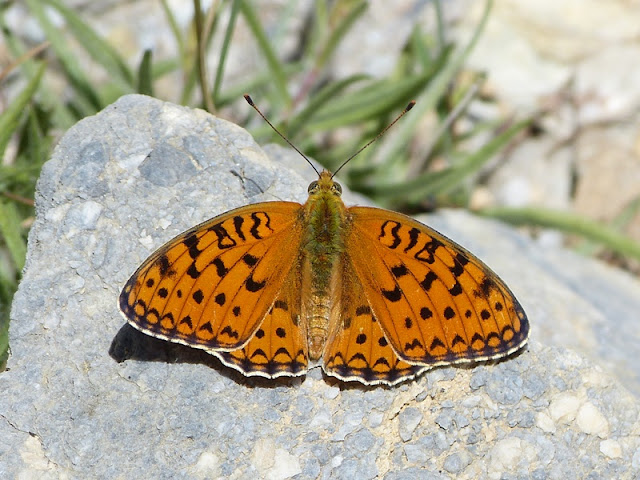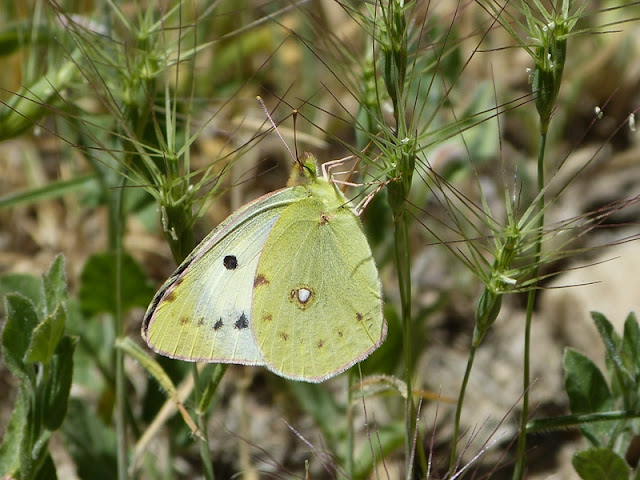We have visited the same holiday villa north west of Malaga
every second year since 2012 and more by chance than design I have driven the
three hour trip to the Sierra Nevada on the 4th of July each time. It has been
interesting to see the differences in butterflies each time.
This year I drove straight up to the Hoya de la Mora ski
resort, arriving just before 9 o'clock, with the intention of heading straight
up to look for Zullich's Blues, Agriades
zullichii. However, as soon as I stepped out of the car I discovered that
it was really windy up there.
Having driven so far, I thought that I may as well walk up
the mountain to have a look anyway, hoping that the wind may die down. However,
I didn't see any butterflies at all.
I then decided to walk down to the stream that I have
visited in the past thinking that it would be more sheltered there. However,
the wind seemed to be blowing straight down the valley, so all I saw all
morning were two Common Blues, a Painted Lady, two Clouded Yellows and a Small
Tortoiseshell, all sheltering from the wind.
Rather disheartened, I gave up and headed back to the car. I
drove back down the mountain and thought that I may as well have a look in a
little meadow where I have seen a lot of butterflies in the past. Normally, I
only spend a few minutes here having spent most of my time in the high
mountains, but this year I had about two and a half hours wondering around an
area no bigger than a football pitch. Luckily this area was completely
sheltered and I was able to see hundreds of butterflies.
The grassy area of the meadow had all sorts of small butterflies,
such as Common Blues. Both Polyommatus
icarus and
Polyommatus celina occur in Sierra Nevada...
Silver-studded Blues, Plebejus
argus hypochionus...
Idas Blues, Plebejus
idas nevadensis...
Southern Brown Argus, Aricia
cramera...
and Small Skippers, Thymelicus
sylvestris.
On previous
visits I have seen the almost identical Essex Skipper, Thymelicus lineola
hemmingi. I think this is one that I saw this year.
In amongst the shrubs were various white butterflies, most
of which wouldn't stop for a picture this year. There were Large Whites, Pieris brassicae, Iberian Marbled Whites,
Melanargia lachesis, Black-veined
Whites, Aporia crataegi, Cleopatras, Gonepteryx cleopatra mauretanica, and Small
Whites, Pieris rapae.
I spotted one rather faded Long-tailed Blue, Lampides boeticus...
And only one Small Copper, Lycaena phlaeas lusitanicus. I am always surprised that they aren't
seen in greater numbers in the Sierra Nevada.
There were also Oriental Meadow Browns, Hyponephele lupinnus, Wall Browns, Lasiommata
megera, and Rock Graylings,
Hipparchia alcyone enjoying a bit of shade. I was delighted
to see a Spanish Gatekeeper, Pyronia
bathseba. It was very difficult to approach, but I did manage a couple of
distant pictures.
While I was stalking it, I saw a Nettle Tree Butterfly, Libythea celtis, the first time I have
managed to see this species. Sadly it flew off before I could take its picture.
But I did manage to get a picture of this Bath White, Pontia daplidice.
There were a few Dusky Heaths, Coenonympha dorus.
In the more open spaces Clouded Yellows, Colias crocea, regularly flew past. Most
were the regular yellow colour, but there were one or two of the pale helice form.
There were a few damp areas in an otherwise dry stream bed,
which were attracting butterflies. Here are three Silver-studded Blues and an
Idas Blue.
There were also some Small Tortoiseshells, Aglais urticae, enjoying the minerals.
I started to follow the stream bed down the hill and I was
thrilled to see a Mother-of-pearl Blue, Plebicula
nivescens. This was the first time I have seen this beautiful butterfly.
Further down the stream I noticed some fritillaries flying
around. I think I had better talk about them in my
next post.






























